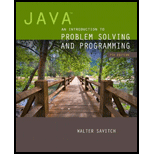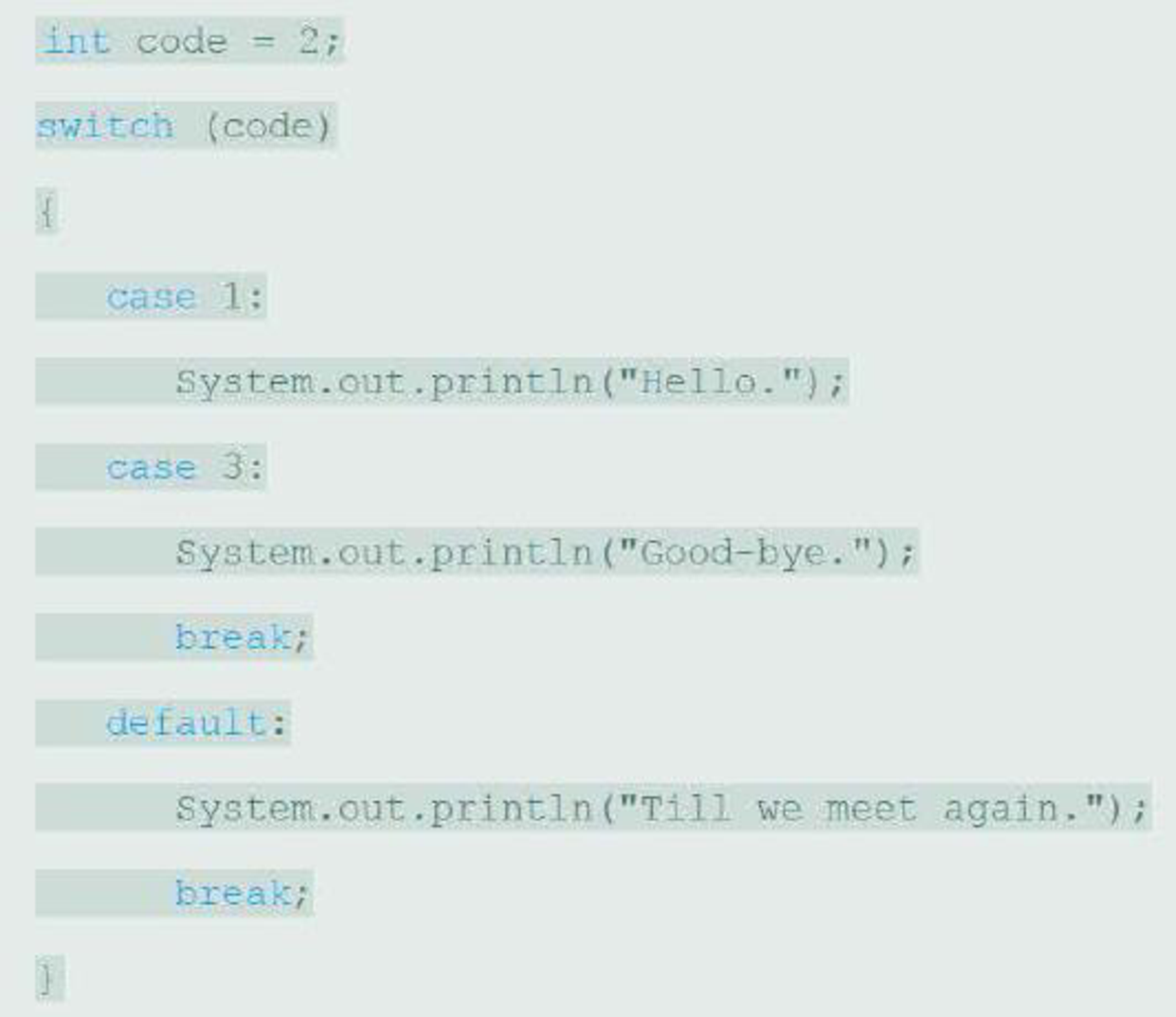
Java: An Introduction to Problem Solving and Programming (7th Edition)
7th Edition
ISBN: 9780133766264
Author: Walter Savitch
Publisher: PEARSON
expand_more
expand_more
format_list_bulleted
Textbook Question
Chapter 3.3, Problem 15STQ
What output is produced by the following code?

Expert Solution & Answer
Trending nowThis is a popular solution!

Students have asked these similar questions
I need to define and discuss the uses of one monitoring or troubleshooting tool in Windows Server 2019. thank you
I would likr toget help with the following concepts:
- Windows Server features
- Windows Server versus Windows 10 used as a client-server network
I need to define and discuss the uses of one monitoring or troubleshooting tool in Windows Server 2019. thank you
Chapter 3 Solutions
Java: An Introduction to Problem Solving and Programming (7th Edition)
Ch. 3.1 - Suppose goals is a variable of type int. Write an...Ch. 3.1 - Suppose goals and errors are variables of type...Ch. 3.1 - Suppose salary and deductions are variables of...Ch. 3.1 - Suppose speed and visibility are variables of type...Ch. 3.1 - Suppose salary and bonus are variables of type...Ch. 3.1 - Assume that nextWord is a string variable that has...Ch. 3.1 - Prob. 7STQCh. 3.1 - What output is produced by the following code? int...Ch. 3.1 - Suppose you change the code in the previous...Ch. 3.1 - What output is produced by the following code? int...
Ch. 3.2 - Suppose number is a variable of type int that has...Ch. 3.2 - What output is produced by the following...Ch. 3.2 - What output is produced by the following...Ch. 3.2 - What output is produced by the following...Ch. 3.3 - What output is produced by the following code?Ch. 3.3 - Suppose you change the code in the previous...Ch. 3.3 - What output is produced by the following code?Ch. 3.3 - What output is produced by the following code?Ch. 3.3 - Suppose you change the first line of the code in...Ch. 3.3 - Prob. 20STQCh. 3.4 - Prob. 21STQCh. 3.4 - Prob. 22STQCh. 3.4 - Write code for a JOptionPane dialog that will ask...Ch. 3 - Write a fragment of code that will test whether an...Ch. 3 - Write a fragment of code that will change the...Ch. 3 - Suppose you are writing a program that asks the...Ch. 3 - Prob. 4ECh. 3 - Consider the following fragment of code: What is...Ch. 3 - We would like to assess a service charge for...Ch. 3 - What is the value of each of the following boolean...Ch. 3 - The following code fragment will not compile. Why?...Ch. 3 - Prob. 9ECh. 3 - Consider the boolean expression (2 5) (x 100))....Ch. 3 - Write a switch statement to convert a letter grade...Ch. 3 - Consider the previous question, but include + or ...Ch. 3 - Imagine a program that displays a menu of five...Ch. 3 - Repeat the previous exercise, but define an...Ch. 3 - Repeat Exercise 13, but use a multibranch if-else...Ch. 3 - Given that the int variable temp contains a...Ch. 3 - Write Java statements that create a yes-or-no...Ch. 3 - A number x is divisible by y if the remainder...Ch. 3 - Write a program to read in three nonnegative...Ch. 3 - Write a program that reads three strings from the...Ch. 3 - Write a program that reads a one-line sentence as...Ch. 3 - Write a program that allows the user to convert a...Ch. 3 - Write a program that inputs an integer. If the...Ch. 3 - Prob. 7PCh. 3 - Repeat Programming Project 5 of Chapter 2, but...Ch. 3 - Repeat any of the previous Practice Programs using...Ch. 3 - Suppose that we are working for an online service...Ch. 3 - Write a program that reads a string from the...Ch. 3 - Repeat the calorie-counting program described in...Ch. 3 - Repeat Programming Project 5 but in addition ask...Ch. 3 - Repeat Programming Project 11 in Chapter 2, but if...Ch. 3 - Write a program to play the rock-paper-scissor...Ch. 3 - Prob. 9PPCh. 3 - Repeat Programming Project 8 in Chapter 1, but add...
Additional Engineering Textbook Solutions
Find more solutions based on key concepts
Look at the following pseudocode class definitions: Class Plant Public Module message() Display "I'm a plant." ...
Starting Out with Programming Logic and Design (5th Edition) (What's New in Computer Science)
This optional Google account security feature sends you a message with a code that you must enter, in addition ...
SURVEY OF OPERATING SYSTEMS
Today, CPUs are huge devices made of electrical and mechanical components such as vacuum tubes and switches.
Starting Out with Python (4th Edition)
a. What is operator precedence? b. Depending on operator precedence, what values could be associated with the e...
Computer Science: An Overview (13th Edition) (What's New in Computer Science)
A method in a subclass that has the same signature as a method in the superclass is an example of __________. a...
Starting Out with Java: From Control Structures through Data Structures (4th Edition) (What's New in Computer Science)
102* The sum of seven interior angles ofa closed-polygon traverse each read to the nearest
3 ” is
$99 a 59 '39...
Elementary Surveying: An Introduction To Geomatics (15th Edition)
Knowledge Booster
Learn more about
Need a deep-dive on the concept behind this application? Look no further. Learn more about this topic, computer-science and related others by exploring similar questions and additional content below.Similar questions
- Please solve and answer the questions correctly please. Thank you!!arrow_forwardConsidering the TM example of binary sum ( see attached)do the step-by-step of execution for the binary numbers 1101 and 11. Feel free to use the Formal Language Editor Tool to execute it; Write it down the current state of the tape (including the head position) and indicate the current state of the TM at each step.arrow_forwardI need help on inculding additonal code where I can can do the opposite code of MatLab, where the function of t that I enter becomes the result of F(t), in other words, turning the time-domain f(t) into the frequency-domain function F(s):arrow_forward
arrow_back_ios
SEE MORE QUESTIONS
arrow_forward_ios
Recommended textbooks for you
 C++ Programming: From Problem Analysis to Program...Computer ScienceISBN:9781337102087Author:D. S. MalikPublisher:Cengage Learning
C++ Programming: From Problem Analysis to Program...Computer ScienceISBN:9781337102087Author:D. S. MalikPublisher:Cengage Learning Microsoft Visual C#Computer ScienceISBN:9781337102100Author:Joyce, Farrell.Publisher:Cengage Learning,
Microsoft Visual C#Computer ScienceISBN:9781337102100Author:Joyce, Farrell.Publisher:Cengage Learning, EBK JAVA PROGRAMMINGComputer ScienceISBN:9781337671385Author:FARRELLPublisher:CENGAGE LEARNING - CONSIGNMENT
EBK JAVA PROGRAMMINGComputer ScienceISBN:9781337671385Author:FARRELLPublisher:CENGAGE LEARNING - CONSIGNMENT C++ for Engineers and ScientistsComputer ScienceISBN:9781133187844Author:Bronson, Gary J.Publisher:Course Technology PtrProgramming Logic & Design ComprehensiveComputer ScienceISBN:9781337669405Author:FARRELLPublisher:Cengage
C++ for Engineers and ScientistsComputer ScienceISBN:9781133187844Author:Bronson, Gary J.Publisher:Course Technology PtrProgramming Logic & Design ComprehensiveComputer ScienceISBN:9781337669405Author:FARRELLPublisher:Cengage

C++ Programming: From Problem Analysis to Program...
Computer Science
ISBN:9781337102087
Author:D. S. Malik
Publisher:Cengage Learning

Microsoft Visual C#
Computer Science
ISBN:9781337102100
Author:Joyce, Farrell.
Publisher:Cengage Learning,

EBK JAVA PROGRAMMING
Computer Science
ISBN:9781337671385
Author:FARRELL
Publisher:CENGAGE LEARNING - CONSIGNMENT

C++ for Engineers and Scientists
Computer Science
ISBN:9781133187844
Author:Bronson, Gary J.
Publisher:Course Technology Ptr

Programming Logic & Design Comprehensive
Computer Science
ISBN:9781337669405
Author:FARRELL
Publisher:Cengage
C++ Programming Tutorial 36 - Intro to Loops; Author: Caleb Curry;https://www.youtube.com/watch?v=M3o7Y0juEP0;License: Standard YouTube License, CC-BY